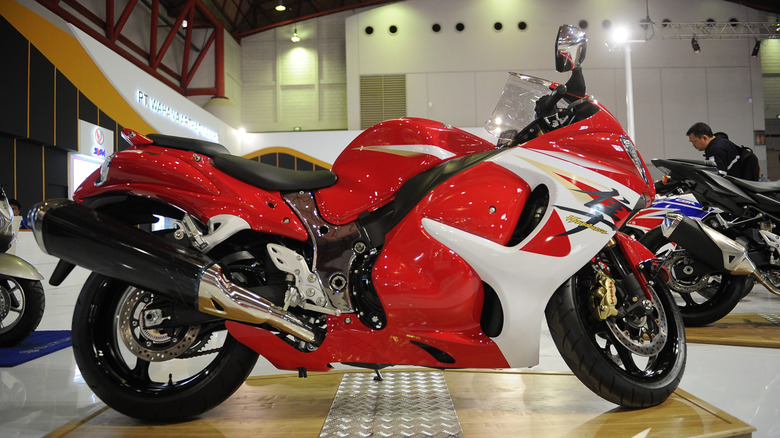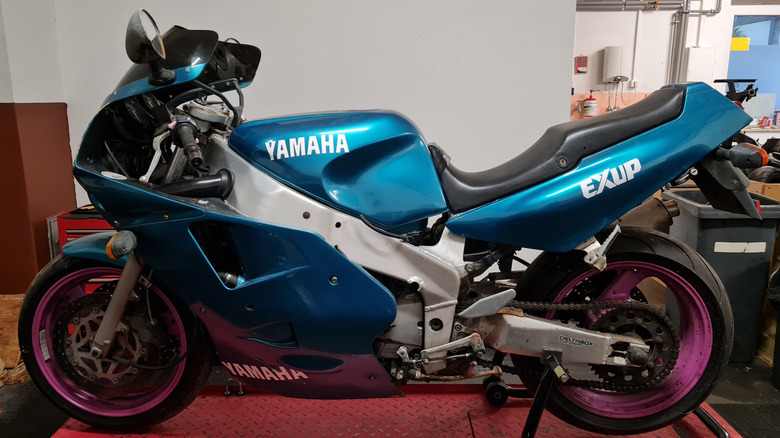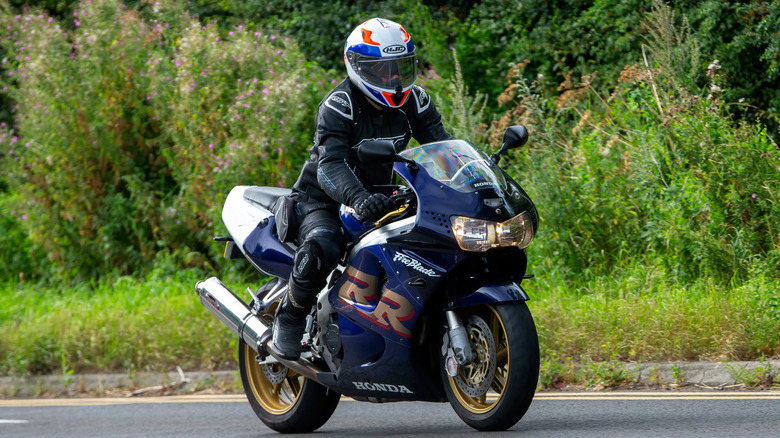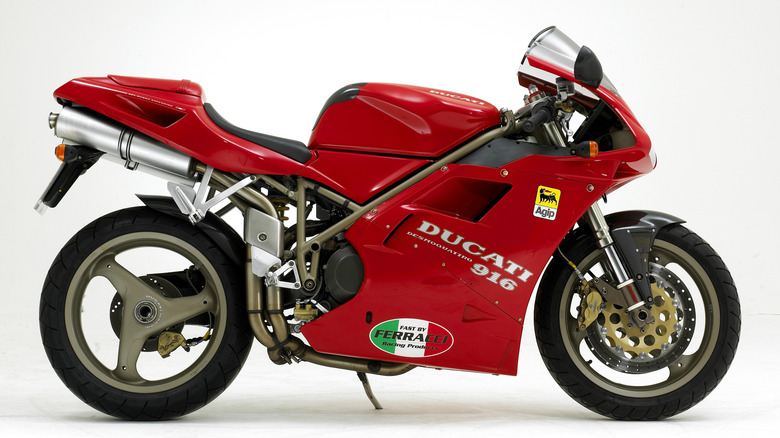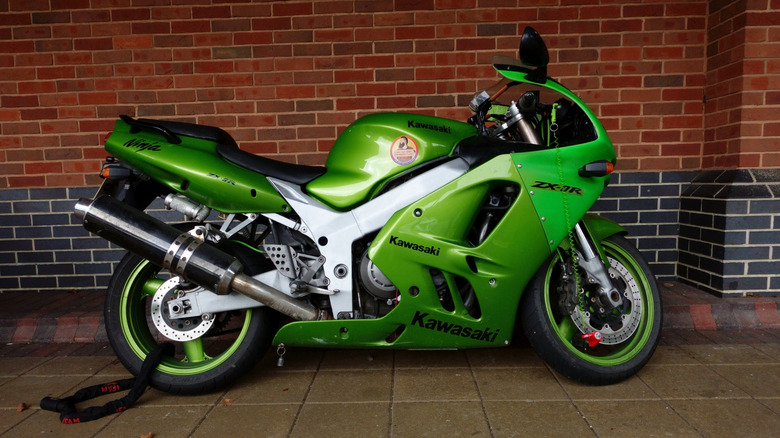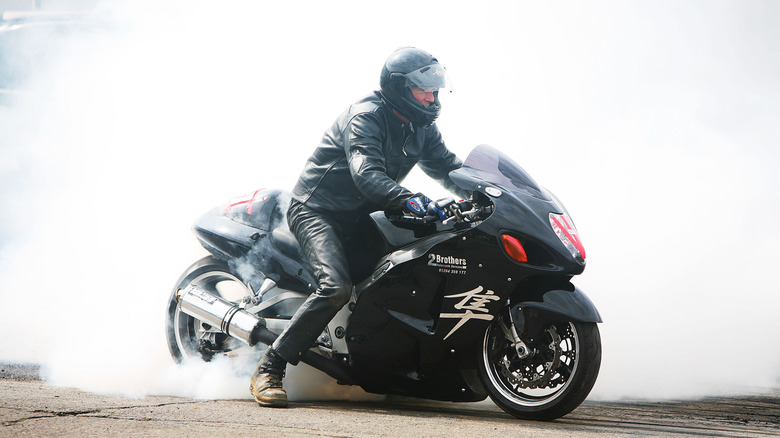5 Of The Fastest Motorcycles From The 1990s
One of the sacred creeds of the automotive world is that nobody remains king for long. Every time a new car or a new bike blows the minds of the public with its abilities, a new competitor comes along to take the throne. This has remained true for as long as people have been building bikes, and each decade trumps the last with new creations that are smarter, stronger, and faster.
Although the concept of the super bike was pioneered in 1969 with the Honda CB750, it wasn't until the 1990s that these bikes were commonly able to reach speeds above the 150 mph mark. Even the fastest bikes of the 1970s paled in comparison to what would come in the '90s. Higher horsepower figures, video game styling, and new technologies would all pave the way for the bikes of the era to become future icons, but there still remains greats among greats. Here are five of the fastest motorcycles from the 1990s.
1991 Yamaha FZR1000
The 1991 Yamaha FZR1000 is a testament to motorsport engineering and just how clever people can get when they want to go fast. Firstly, the FZR1000 is the lucky recipient of Yamaha's coveted Genesis. The Genesis includes a large displacement of 1,002 cc with an in-line four layout, which in the FZR1000, produces 133 hp. The engine is fed air by Yamaha's Fresh Air Intake System (FAI), which consists of a warping trail of tubes and ducts that pull in dense air from the front of the bike.
Once all that air is transformed into horsepower, it is sent out via a special exhaust system that Yamaha calls the EXUP, standing for Exhaust Ultimate Powervalve. The EXUP system was a game-changer. Usually, when designing exhaust systems, the engineers have to accept that their creation will only work at its optimal level within a specific RPM range. The length and diameter of any given exhaust system will affect the back pressure differently at different RPMs, meaning that its window for maximum performance is small. The EXUP system solves this conundrum by using a servo motor to open and close a series of valves in the four exhaust headers. The ECU informs the motor and adjusts its valve configuration according to the bike's needs. All of this mathematical magic results in a bike that tops out at 158 mph, making it one of the fastest Yamaha motorcycles ever made.
1992 Honda CBR900RR
The bike world's high-speed craze of the 1990s resulted in many lightning-fast bikes, but many of these examples had to make sacrifices to comfortably meet their maker's expectations. Motorcycles gained weight in the name of bigger engines, or lost agility in favor of aerodynamics, whose sole purpose was to keep bike and rider stable in a straight line in pursuit of the top speed title. However, Tadao Baba, one of Honda's most respected motorcycle engineers and a dedicated rider himself, thought differently. In his mind, these high-speed missiles had forgotten their purpose, and so had lost touch with the true nature of a sport bike.
His solution was the 1992 Honda CBR900RR. The CBR900RR was sharp, angular, and just plain cool. It was also small and light, only 408 lbs dry to be exact. It borrowed the engine from the Honda RVF750, an in-line four cylinder, and added some extra displacement. Combine a bike that weighs 408 lbs with a 893 cc, 122 hp engine, and you're set to make one very quick lap time. The low weight meant riders could lean and whip it around corners without sweaty palms, but it also lent itself well to straight-line speed. The CBR900RR could zoom all the way up to 160 mph— a highly impressive feat when you consider it did not compromise when it came to agility.
1994 Ducati 916
Like almost every motor-related creation that comes out of Italy, the Ducati 916 looks very good. This is thanks to Massimo Tamburini, the legendary Italian motorbike designer whose mind and hand birthed the Ducati 916 in 1994. The bike looks like it's in motion even when still, with the lower fairing reaching close to the ground and the exhaust pipe tucked under the rear cowl stabbing out above the rear wheel. If it wasn't clear by its looks, the 916 is a superbike — a fact further proven when you look at its specs and abilities.
The 916 is powered by a 916 cc V-twin engine that pushes out 114 hp at a shrill 9,000 rpm. The 916 also weighs between 450 and 475 pounds, meaning this Italian superbike can blast from 0 to 60 in just 3 seconds. Keep going past the 60 mph mark, and you will reach its top speed of 161 mph not long after. Beyond its abilities, though, the 916 is truly a special bike. Its design was fresh and evocative for the time, blending street-going looks with track-focused agility and speed. It helped usher in a new era for sport bikes, set the foundations for Ducati's future designs, and became a true head-turning bike that defined the 1990s.
1990 Kawasaki Ninja ZX-11
In 1990, the world received one of the fastest bikes of the decade in the 1990 Kawasaki Ninja ZX-11. This decade-defining rocket for the brand could reach a blistering 176 mph, all thanks to some clever engineering and manipulation of air. The brunt of the heavy lifting as the ZX-11 climbs the speedometer is done by the same physics principles as a supercharger, creating compressed air to feed the hungry engine. The value of compressed air is that it is of a higher density and contains more oxygen, and more oxygen means more combustion, with the final result being more power. Where a supercharger is a constructed component of the engine, usually powered by the timing belt or an electrical motor, the ram air effect in the ZX-11 is done much more naturally.
The ZX-11 utilizes a straightforward venting pathway that draws air from the front fairing and directs it directly into the engine's carburetors, effectively creating the effect of a supercharger without the added weight. It is by no means a simple system, though. Kawasaki made sure to make this boost system as efficient as possible by adding sensors inside the air pathway that help the engine computer calculate the most effective fuel-to-air mix for any given speed. Its performance and innovation make the Kawasaki Ninja one of the most famous motorcycles ever made.
1999 Suzuki Hayabusa
Though all the formerly mentioned bikes are supremely fast, there is one clear king of speed for the '90s. Hayabusa is Japanese for "peregrine falcon", a fitting name for Suzuki's masterpiece of speed. Even by just looking at it, you can tell the Hayabusa is in a class of its own. It's noticeably longer than most bikes, with bulky panels that give it a missile-like appearance. These looks aren't just for show, though. The length helps the Hayabusa stay upright at high speeds, and its muscular body paneling is extensive, covering as much of the internals as possible, which results in a more streamlined profile.
Like many of the speediest bikes of the era, the Hayabusa is powered by an inline four-cylinder, this one making 175 hp. It's heavy compared to some sportbikes, weighing in at 473 lbs dry, but thanks to that high horsepower figure, its muscular size is inconsequential. But its performance wasn't all thanks to pure power. The engine cylinders featured Suzuki Composite Electrochemical Material (SCEM), which is a nickel-silicon-carbide coating that assists with heat dissipation, allowing the Hayabusa's engine to run at maximum power without overheating while simultaneously improving cylinder longevity. The Hayabusa is an engineering achievement whose inner workings and clever constructions could be swooned over for hours, but at the end of the day, only one metric matters — a top speed in the 190 mph range.
